Barys Shyrokau
Reducing Discomfort in Driving Simulators: Motion Cueing for Motion Sickness Mitigation
Oct 02, 2025Abstract:Driving simulators are increasingly used in research and development. However, simulators often cause motion sickness due to downscaled motion and unscaled veridical visuals. In this paper, a motion cueing algorithm is proposed that reduces motion sickness as predicted by the subjective vertical conflict (SVC) model using model predictive control (MPC). Both sensory conflict and specific force errors are penalised in the cost function, allowing the algorithm to jointly optimise fidelity and comfort. Human-in-the-loop experiments were conducted to compare four simulator motion settings: two variations of our MPC-based algorithm, one focused on pure specific force tracking and the second compromising specific force tracking and motion sickness minimisation, as well as reference adaptive washout and no motion cases. The experiments were performed on a hexapod driving simulator with participants exposed to passive driving. Experimental motion sickness results closely matched the sickness model predictions. As predicted by the model, the no motion condition yielded the lowest sickness levels. However, it was rated lowest in terms of fidelity. The compromise solution reduced sickness by over 50% (average MISC level 3 to 1.5) compared to adaptive washout and the algorithm focusing on specific force tracking, without any significant reduction in fidelity rating. The proposed approach for developing MCA that takes into account both the simulator dynamics and time evolution of motion sickness offers a significant advancement in achieving an optimal control of motion sickness and specific force recreation in driving simulators, supporting broader simulator use.
A Vehicle System for Navigating Among Vulnerable Road Users Including Remote Operation
May 08, 2025Abstract:We present a vehicle system capable of navigating safely and efficiently around Vulnerable Road Users (VRUs), such as pedestrians and cyclists. The system comprises key modules for environment perception, localization and mapping, motion planning, and control, integrated into a prototype vehicle. A key innovation is a motion planner based on Topology-driven Model Predictive Control (T-MPC). The guidance layer generates multiple trajectories in parallel, each representing a distinct strategy for obstacle avoidance or non-passing. The underlying trajectory optimization constrains the joint probability of collision with VRUs under generic uncertainties. To address extraordinary situations ("edge cases") that go beyond the autonomous capabilities - such as construction zones or encounters with emergency responders - the system includes an option for remote human operation, supported by visual and haptic guidance. In simulation, our motion planner outperforms three baseline approaches in terms of safety and efficiency. We also demonstrate the full system in prototype vehicle tests on a closed track, both in autonomous and remotely operated modes.
Efficient Motion Sickness Assessment: Recreation of On-Road Driving on a Compact Test Track
Dec 19, 2024Abstract:The ability to engage in other activities during the ride is considered by consumers as one of the key reasons for the adoption of automated vehicles. However, engagement in non-driving activities will provoke occupants' motion sickness, deteriorating their overall comfort and thereby risking acceptance of automated driving. Therefore, it is critical to extend our understanding of motion sickness and unravel the modulating factors that affect it through experiments with participants. Currently, most experiments are conducted on public roads (realistic but not reproducible) or test tracks (feasible with prototype automated vehicles). This research study develops a method to design an optimal path and speed reference to efficiently replicate on-road motion sickness exposure on a small test track. The method uses model predictive control to replicate the longitudinal and lateral accelerations collected from on-road drives on a test track of 70 m by 175 m. A within-subject experiment (47 participants) was conducted comparing the occupants' motion sickness occurrence in test-track and on-road conditions, with the conditions being cross-randomized. The results illustrate no difference and no effect of the condition on the occurrence of the average motion sickness across the participants. Meanwhile, there is an overall correspondence of individual sickness levels between on-road and test-track. This paves the path for the employment of our method for a simpler, safer and more replicable assessment of motion sickness.
A Learning-Based Model Predictive Contouring Control for Vehicle Evasive Manoeuvres
Aug 08, 2024Abstract:This paper presents a novel Learning-based Model Predictive Contouring Control (L-MPCC) algorithm for evasive manoeuvres at the limit of handling. The algorithm uses the Student-t Process (STP) to minimise model mismatches and uncertainties online. The proposed STP captures the mismatches between the prediction model and the measured lateral tyre forces and yaw rate. The mismatches correspond to the posterior means provided to the prediction model to improve its accuracy. Simultaneously, the posterior covariances are propagated to the vehicle lateral velocity and yaw rate along the prediction horizon. The STP posterior covariance directly depends on the variance of observed data, so its variance is more significant when the online measurements differ from the recorded ones in the training set and smaller in the opposite case. Thus, these covariances can be utilised in the L-MPCC's cost function to minimise the vehicle state uncertainties. In a high-fidelity simulation environment, we demonstrate that the proposed L-MPCC can successfully avoid obstacles, keeping the vehicle stable while driving a double lane change manoeuvre at a higher velocity than an MPCC without STP. Furthermore, the proposed controller yields a significantly lower peak sideslip angle, improving the vehicle's manoeuvrability compared to an L-MPCC with a Gaussian Process.
A Nonlinear Model Predictive Control for Automated Drifting with a Standard Passenger Vehicle
May 17, 2024Abstract:This paper presents a novel approach to automated drifting with a standard passenger vehicle, which involves a Nonlinear Model Predictive Control to stabilise and maintain the vehicle at high sideslip angle conditions. The proposed controller architecture is split into three components. The first part consists of the offline computed equilibrium maps, which provide the equilibrium points for each vehicle state given the desired sideslip angle and radius of the path. The second is the predictive controller minimising the errors between the equilibrium and actual vehicle states. The third is a path-following controller, which reduces the path error, altering the equilibrium curvature path. In a high-fidelity simulation environment, we validate the controller architecture capacity to stabilise the vehicle in automated drifting along a desired path, with a maximal lateral path deviation of 1 m. In the experiments with a standard passenger vehicle, we demonstrate that the proposed approach is capable of bringing and maintaining the vehicle at the desired 30 deg sideslip angle in both high and low friction conditions.
Motion Cueing Algorithm for Effective Motion Perception: A frequency-splitting MPC Approach
Sep 04, 2023

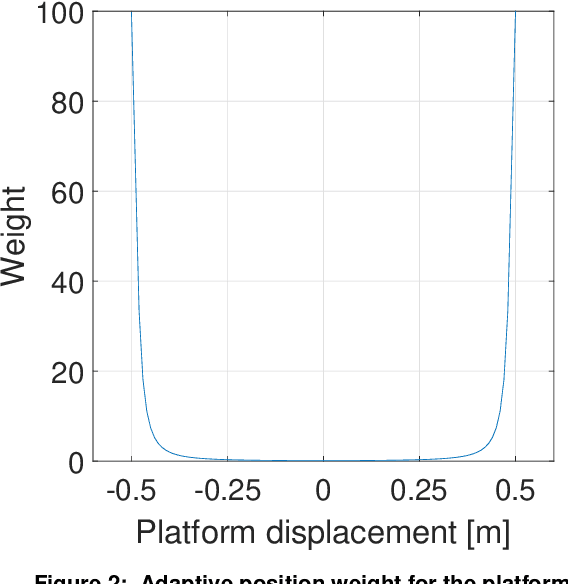
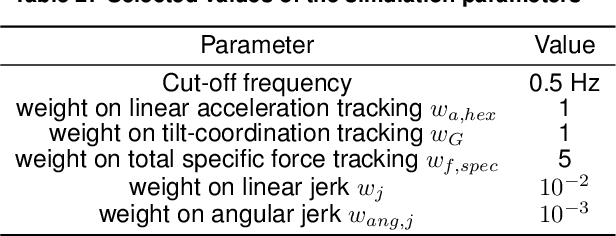
Abstract:Model predictive control (MPC) is a promising technique for motion cueing in driving simulators, but its high computation time limits widespread real-time application. This paper proposes a hybrid algorithm that combines filter-based and MPC-based techniques to improve specific force tracking while reducing computation time. The proposed algorithm divides the reference acceleration into low-frequency and high-frequency components. The high-frequency component serves as a reference for translational motion to avoid workspace limit violations, while the low-frequency component is for tilt coordination. The total acceleration serves as a reference for combined specific force with the highest priority to enable compensation of deviations from its reference values. The algorithm uses constraints in the MPC formulation to account for workspace limits and workspace management is applied. The investigated scenarios were a step signal, a multi-sine wave and a recorded real-drive slalom maneuver. Based on the conducted simulations, the algorithm produces approximately 15% smaller root means squared error (RMSE) for the step signal compared to the state-of-the-art. Around 16% improvement is observed when the real-drive scenario is used as the simulation scenario, and for the multi-sine wave, 90% improvement is observed. At higher prediction horizons the algorithm matches the performance of a state-of-the-art MPC-based motion cueing algorithm. Finally, for all prediction horizons, the frequency-splitting algorithm produced faster results. The pre-generated references reduce the required prediction horizon and computational complexity while improving tracking performance. Hence, the proposed frequency-splitting algorithm outperforms state-of-the-art MPC-based algorithm and offers promise for real-time application in driving simulators.
Model Predictive Contouring Control for Vehicle Obstacle Avoidance at the Limit of Handling
Aug 13, 2023Abstract:This paper proposes a non-linear Model Predictive Contouring Control (MPCC) for obstacle avoidance in automated vehicles driven at the limit of handling. The proposed controller integrates motion planning, path tracking and vehicle stability objectives, prioritising obstacle avoidance in emergencies. The controller's prediction model is a non-linear single-track vehicle model with the Fiala tyre to capture the vehicle's non-linear behaviour. The MPCC computes the optimal steering angle and brake torques to minimise tracking error in safe situations and maximise the vehicle-to-obstacle distance in emergencies. Furthermore, the MPCC is extended with the tyre friction circle to fully exploit the vehicle's manoeuvrability and stability. The MPCC controller is tested using real-time rapid prototyping hardware to prove its real-time capability. The performance is compared with a state-of-the-art Model Predictive Control (MPC) in a high-fidelity simulation environment. The double lane change scenario results demonstrate a significant improvement in successfully avoiding obstacles and maintaining vehicle stability.
Computationally-efficient Motion Cueing Algorithm via Model Predictive Control
Apr 06, 2023



Abstract:Driving simulators have been used in the automotive industry for many years because of their ability to perform tests in a safe, reproducible and controlled immersive virtual environment. The improved performance of the simulator and its ability to recreate in-vehicle experience for the user is established through motion cueing algorithms (MCA). Such algorithms have constantly been developed with model predictive control (MPC) acting as the main control technique. Currently, available MPC-based methods either compute the optimal controller online or derive an explicit control law offline. These approaches limit the applicability of the MCA for real-time applications due to online computational costs and/or offline memory storage issues. This research presents a solution to deal with issues of offline and online solving through a hybrid approach. For this, an explicit MPC is used to generate a look-up table to provide an initial guess as a warm-start for the implicit MPC-based MCA. From the simulations, it is observed that the presented hybrid approach is able to reduce online computation load by shifting it offline using the explicit controller. Further, the algorithm demonstrates a good tracking performance with a significant reduction of computation time in a complex driving scenario using an emulator environment of a driving simulator.
Search-Based Task and Motion Planning for Hybrid Systems: Agile Autonomous Vehicles
Jan 25, 2023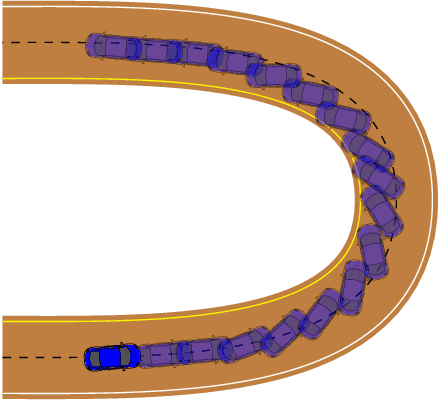
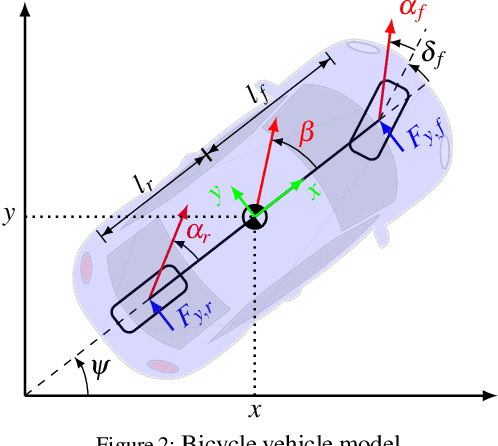
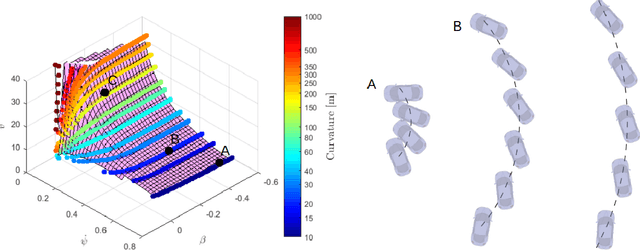
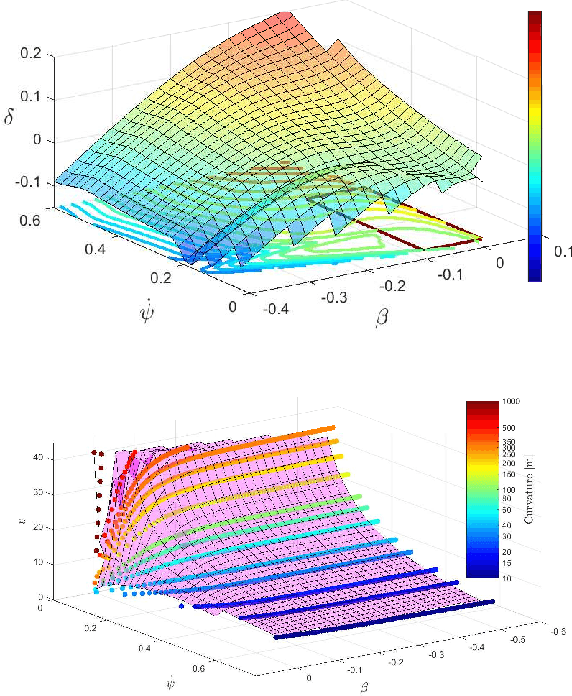
Abstract:To achieve optimal robot behavior in dynamic scenarios we need to consider complex dynamics in a predictive manner. In the vehicle dynamics community, it is well know that to achieve time-optimal driving on low surface, the vehicle should utilize drifting. Hence many authors have devised rules to split circuits and employ drifting on some segments. These rules are suboptimal and do not generalize to arbitrary circuit shapes (e.g., S-like curves). So, the question "When to go into which mode and how to drive in it?" remains unanswered. To choose the suitable mode (discrete decision), the algorithm needs information about the feasibility of the continuous motion in that mode. This makes it a class of Task and Motion Planning (TAMP) problems, which are known to be hard to solve optimally in real-time. In the AI planning community, search methods are commonly used. However, they cannot be directly applied to TAMP problems due to the continuous component. Here, we present a search-based method that effectively solves this problem and efficiently searches in a highly dimensional state space with nonlinear and unstable dynamics. The space of the possible trajectories is explored by sampling different combinations of motion primitives guided by the search. Our approach allows to use multiple locally approximated models to generate motion primitives (e.g., learned models of drifting) and effectively simplify the problem without losing accuracy. The algorithm performance is evaluated in simulated driving on a mixed-track with segments of different curvatures (right and left). Our code is available at https://git.io/JenvB
Comfort-oriented driving: performance comparison between human drivers and motion planners
Jan 25, 2023Abstract:Motion planning is a fundamental component in automated vehicles. It influences the comfort and time efficiency of the ride. Despite a vast collection of studies working towards improving motion comfort in self-driving cars, little attention has been paid to the performance of human drivers as a baseline. In this paper, we present an experimental study conducted on a public road using an instrumented vehicle to investigate how human drivers balance comfort and time efficiency. The human driving data is compared with two optimization-based motion planners that we developed in the past. In situations when there is no difference in travel times, human drivers incurred an average of 23.5% more energy in the longitudinal and lateral acceleration signals than the motion planner that minimizes accelerations. In terms of frequency-weighted acceleration energy, an indicator correlated with the incidence of motion sickness, the average performance deficiency rises to 70.2%. Frequency-domain analysis reveals that human drivers exhibit more longitudinal oscillations in the frequency range of 0.2-1 Hz and more lateral oscillations in the frequency range of up to 0.2 Hz. This is reflected in time-domain data features such as less smooth speed profiles and higher velocities for long turns. The performance difference also partly results from several practical matters and additional factors considered by human drivers when planning and controlling vehicle motion. The driving data collected in this study provides a performance baseline for motion planning algorithms to compare with and can be further exploited to deepen the understanding of human drivers.
 Add to Chrome
Add to Chrome Add to Firefox
Add to Firefox Add to Edge
Add to Edge